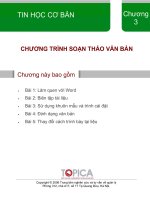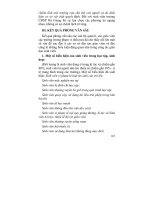chương 3: Requirements Evaluation potx
Bạn đang xem bản rút gọn của tài liệu. Xem và tải ngay bản đầy đủ của tài liệu tại đây (963.81 KB, 54 trang )
www.wileyeurope .com/college/van lamsweerde Chap.3: Requirements Evaluation © 2009 John Wiley and Sons
1
Requirements Engineering
From System Goals
to UML Models
to Software Specifications
Axel Van Lamsweerde
www.wileyeurope .com/college/van lamsweerde Chap.3: Requirements Evaluation © 2009 John Wiley and Sons
2
Fundamentals of RE
Fundamentals of RE
Chapter 3
Requirements Evaluation
3
www.wileyeurope .com/college/van lamsweerde Chap.3: Requirements Evaluation © 2009 John Wiley and Sons
start
Chap. 2:
Elicitation
techniques
Chap. 3:
Chap. 3:
Evaluation
Evaluation
techniques
techniques
alternative options
agreed
requirements
documented requirements
consolidated
requirements
Chap.1: RE products and processes
4
www.wileyeurope .com/college/van lamsweerde Chap.3: Requirements Evaluation © 2009 John Wiley and Sons
Negotiation-based decision making:
as introduced in Chapter 1
Identification & resolution of
inconsistencies
inconsistencies
–
conflicting stakeholder viewpoints, non-functional reqs,
– to reach agreement
Identification, assessment & resolution of system
risks
risks
– critical objectives not met, e.g. safety hazards, security
threats, development risks,
– to get new reqs for more robust system-to-be
Comparison of
alternative options
alternative options, selection of preferred ones
– different ways of: meeting same objective, assigning
responsibilities, resolving conflicts & risks
Requirements
prioritization
prioritization
–
to resolve conflicts, address cost/schedule constraints,
support incremental development
5
www.wileyeurope .com/college/van lamsweerde Chap.3: Requirements Evaluation © 2009 John Wiley and Sons
Requirements evaluation: outline
Inconsistency management
–
Types of inconsistency
– Handling inconsistencies
–
Managing conflicts: a systematic process
Risk analysis
–
Types of risk
– Risk management
–
Risk documentation
– DDP: quantitative risk management for RE
Evaluating alternative options for decision making
Requirements prioritization
6
www.wileyeurope .com/college/van lamsweerde Chap.3: Requirements Evaluation © 2009 John Wiley and Sons
Inconsistency management
Inconsistency = violation of consistency rule among items
Inconsistencies are highly frequent in RE
–
inter-viewpoints
inter-viewpoints: each stakeholder has its own focus &
concerns (e.g. domain experts
vs.
marketing dept)
–
intra-viewpoint
intra-viewpoint: conflicting quality reqs (e.g. security
vs.
usability)
Inconsistencies must be detected and resolved
–
not too soon: to allow further elicitation within viewpoint
– not too late: to allow software development
(anything may be developed from inconsistent specs)
7
www.wileyeurope .com/college/van lamsweerde Chap.3: Requirements Evaluation © 2009 John Wiley and Sons
Types of inconsistency in RE
Terminology clash
Terminology clash: same concept named differently in
different statements
e.g. library management: “borrower”
vs.
“patron”
Designation clash
Designation clash: same name for different concepts in
different statements
e.g. “user” for “library user”
vs.
“library software user”
Structure clash
Structure clash: same concept structured differently in
different statements
e.g. “latest return date” as time point (e.g. Fri 5pm)
vs.
time interval (e.g. Friday)
8
www.wileyeurope .com/college/van lamsweerde Chap.3: Requirements Evaluation © 2009 John Wiley and Sons
Types of inconsistency in RE (2)
Strong conflict
Strong conflict: statements not satisfiable together
–
i.e. logically inconsistent:
S
,
not S
e.g. “participant constraints may not be disclosed to anyone else”
vs.
“the meeting initiator should know participant constraints”
Weak conflict
Weak conflict (divergence): statements not satisfiable
together under some
boundary condition
boundary condition
–
i.e.
strongly conflicting if
B
holds:
potential
conflict
– MUCH more frequent in RE
e.g. (staff’s viewpoint)
“patrons shall return borrowed copies within
X
weeks”
vs.
(patron’s viewpoint)
“patrons shall keep borrowed copies as long as needed”
B:
“a patron needing a borrowed copy more than
X
weeks”
9
www.wileyeurope .com/college/van lamsweerde Chap.3: Requirements Evaluation © 2009 John Wiley and Sons
Handling inconsistencies
Handling clashes in terminology, designation, structure:
through agreed
glossary of terms
glossary of terms to stick to
– For some terms, if needed: accepted synonym(s)
– To be built during elicitation phase
Weak, strong conflicts: more difficult, deeper causes
–
Often rooted in underlying personal objectives of
stakeholders => to be handled at root level and propagated
to requirements level
–
Inherent to some non-functional concerns (performance
vs.
safety, confidentiality
vs.
awareness, ) => exploration of
preferred tradeoffs
– Example: spiral, negotiation-based reconciliation of
win
conditions [Boehm et al, 1995]
10
www.wileyeurope .com/college/van lamsweerde Chap.3: Requirements Evaluation © 2009 John Wiley and Sons
Managing conflicts: a systematic process
Overlap
Overlap = reference to common terms or phenomena
– precondition for conflicting statements
–
e.g. gathering meeting constraints, determining schedules
Conflict detection
Conflict detection (see Chapters 16, 18)
–
informally
–
using heuristics on conflicting req categories
“Check
information
req &
confidentiality
req on related objects”
“Check reqs on
decreasing
&
increasing
related quantities”
–
using conflict patterns
–
formally (theorem proving techniques)
Identify
overlapping
statements
Detect conflicts
among them,
document these
Generate
conflict
resolutions
Evaluate
resolutions,
select preferred
11
www.wileyeurope .com/college/van lamsweerde Chap.3: Requirements Evaluation © 2009 John Wiley and Sons
Detected conflicts should be documented
For later resolution, for impact analysis
? statement in multiple conflicts, most conflicting statements, ?
Using documentation tools, query tools along
Conflict
links
recorded in requirements database
Or in
interaction matrix
interaction matrix:
Statement S1 S2 S3 S4
Total
Total S
ij
=
S1 0 1000 1 1 1002 1: conflict
S2 1000 0 0 0 1000 0: no overlap
S3 1 0 0 1 2 1000: no conflict
S4 1 0 1 0 2
Total
Total
1002 1000 2 2 2006
#Conflicts(S
1
) = remainderOf (1002 div 1000)
#nonConflictingOverlaps(S
1
) = quotientOf (1002 div 1000)
12
www.wileyeurope .com/college/van lamsweerde Chap.3: Requirements Evaluation © 2009 John Wiley and Sons
Managing conflicts: a systematic process (2)
For optimal resolution, better to
–
explore multiple candidate resolutions
first
,
–
compare, select/agree on most preferred
next
To generate candidate resolutions, use
–
elicitation techniques
(interviews, group sessions)
–
resolution tactics
Identify
overlapping
statements
Detect conflicts
among them,
document these
Generate
conflict
resolutions
Evaluate
resolutions,
select preferred
13
www.wileyeurope .com/college/van lamsweerde Chap.3: Requirements Evaluation © 2009 John Wiley and Sons
Conflict resolution tactics
Avoid
Avoid boundary condition
e.g. “Keep copies of highly needed books
unborrowable”
Restore
Restore conflicting statements
e.g. “Copy returned within X weeks
and then
borrowed
again”
Weaken
Weaken conflicting statements
e.g. “Copy returned within X weeks
unless
explicit
permission”
Drop
Drop lower-priority statements
Specialize
Specialize conflict source or target
e.g. “Book loan status known
by staff users only
”
Transform conflicting statements or involved objects, or
introduce new requirements
14
www.wileyeurope .com/college/van lamsweerde Chap.3: Requirements Evaluation © 2009 John Wiley and Sons
Managing conflicts: a systematic process (3)
Evaluation criteria for preferred resolution:
– contribution to critical non-functional requirements
–
contribution to resolution of
other
conflicts & risks
See
–
Sect. 3.3 in this chapter (“Evaluating alternative options”)
– Chapters 16, 18
Identify
overlapping
statements
Detect conflicts
among them,
document these
Generate
conflict
resolutions
Evaluate
resolutions,
select preferred
15
www.wileyeurope .com/college/van lamsweerde Chap.3: Requirements Evaluation © 2009 John Wiley and Sons
Requirements evaluation: outline
Inconsistency management
–
Types of inconsistency
– Handling inconsistencies
–
Managing conflicts: a systematic process
Risk analysis
Risk analysis
–
Types of risk
Types of risk
–
Risk management
Risk management
–
Risk documentation
Risk documentation
– DDP: quantitative risk management for RE
Evaluating alternative options for decision making
Requirements prioritization
16
www.wileyeurope .com/college/van lamsweerde Chap.3: Requirements Evaluation © 2009 John Wiley and Sons
What is a risk ?
Uncertain factor whose occurrence may result in
loss of
loss of
satisfaction
satisfaction of a corresponding
objective
objective
e.g.
a passenger forcing doors opening while train moving
a meeting participant not checking email regularly
A risk has
–
a
likelihood
likelihood of occurrence,
– one or more undesirable
consequences
consequences
e.g. passengers falling out of train moving with doors open
Each risk consequence has
–
a
likelihood
likelihood of occurrence if the risk occurs
(not to be confused with risk likelihood)
– a
severity
severity: degree of loss of satisfaction of objective
17
www.wileyeurope .com/college/van lamsweerde Chap.3: Requirements Evaluation © 2009 John Wiley and Sons
Types of RE risk
Product-related
Product-related risks: negative impact on functional or non-
functional objectives of the system
=> failure to deliver services or quality of service
e.g. security threats, safety hazards
Process-related
Process-related risks: negative impact on development
objectives
=> delayed delivery, cost overruns,
e.g. personnel turnover
18
www.wileyeurope .com/college/van lamsweerde Chap.3: Requirements Evaluation © 2009 John Wiley and Sons
RE risk management
Risk management is iterative
– countermeasures may introduce new risks
Poor risk management is a major cause of software failure
– natural inclination to conceive over-ideal systems
(nothing can go wrong)
–
unrecognized, underestimated risks => incomplete,
inadequate reqs
Risk
identification
Risk
assessment
Risk
control
what system-specific
risks?
likely?
severe, likely consequences?
countermeasures
as new reqs
19
www.wileyeurope .com/college/van lamsweerde Chap.3: Requirements Evaluation © 2009 John Wiley and Sons
Risk identification: risk checklists
Instantiation of risk categories to project specifics
–
associated with corresponding req categories (cf. Chap. 1)
Product-related risks: req unsatisfaction in functional or
quality req categories
–
info inaccuracy, unavailability, unusability, poor response
time, poor peak throughput,
e.g. ? inaccurate estimates of train speed, positions ?
Process-related risks: top 10 risks [Boehm, 1989]
–
req volatility, personnel shortfalls, dependencies on
external sources, unrealistic schedules/budgets,
–
poor risk management
e.g. ? unexperienced developer team for train system ?
20
www.wileyeurope .com/college/van lamsweerde Chap.3: Requirements Evaluation © 2009 John Wiley and Sons
Risk identification: component inspection
For product-related risks
Review each component of the system-to-be: human, device,
software component
–
can it fail?
–
how?
–
why?
– what are possible consequences?
e.g. on-board train controller, station computer, tracking system,
communication infrastructure,
Finer-grained components => more accurate analysis
e.g. acceleration controller, doors controller, track sensors,
21
www.wileyeurope .com/college/van lamsweerde Chap.3: Requirements Evaluation © 2009 John Wiley and Sons
Risk identification: risk trees
Tree organization for causal linking of failures, causes,
consequences
–
similar to
fault trees
in safety,
threat trees
in security
Failure node
Failure node = independent failure event or condition
–
decomposable into finer-grained nodes
AND/OR links
AND/OR links: causal links through logical nodes
–
AND-node
AND-node: child nodes must all occur for parent node to
occur as consequence
–
OR-node
OR-node: only one child node needs to occur
22
www.wileyeurope .com/college/van lamsweerde Chap.3: Requirements Evaluation © 2009 John Wiley and Sons
Risk tree: example
Door opens while train moving
Train is moving
OR
AND
Passenger forces
doors to open
Door actuator
fails
Speedometer
fails
Software controller fails
Wrong
requirement
Wrong
assumption
Wrong
specification
Wrong
implementation
OR
leaf node
decomposable node
23
www.wileyeurope .com/college/van lamsweerde Chap.3: Requirements Evaluation © 2009 John Wiley and Sons
Building risk trees:
heuristic identification of failure nodes
Checklists, component failure
Guidewords
Guidewords = keyword-based patterns of failure
–
NO: “something is missing”
–
MORE: “there are more things than expected”
–
LESS: “there are fewer things than expected”
– BEFORE: “something occurs earlier than expected”
– AFTER: “something occurs later than expected”
But problems frequently due to
combinations
of basic
failure events/conditions
24
www.wileyeurope .com/college/van lamsweerde Chap.3: Requirements Evaluation © 2009 John Wiley and Sons
Analyzing failure combinations:
cut set of a risk tree
Cut set
Cut set of risk tree RT: set of minimal AND-
combinations
of RT’s
leaf nodes sufficient for causing RT’s root node
–
Cut-set tree
Cut-set tree of RT: set of its leaf nodes = RT’s cut set
Derivation of cut-set tree CST of RT:
–
CST’s top node := RT’s top logical node
–
If
If current CST node is
OR
OR-node:
expand it with RT’s corresponding alternative child nodes
If
If current CST node is
AND
AND-node:
expand it in single aggregation of RT’s conjoined child nodes
–
Termination when CST’s child nodes are all aggregations of
leaf nodes from RT
25
www.wileyeurope .com/college/van lamsweerde Chap.3: Requirements Evaluation © 2009 John Wiley and Sons
Cut-set tree derivation: example
Cut set =
{{TM,
{{TM,
WR},
WR},
{TM,
{TM,
WA},
WA},
{TM,
{TM,
WS},
WS},
{TM,
{TM,
WI},
WI},
{TM,
{TM,
DAF},
DAF},
{TM,
{TM,
SF},
SF},
{TM,
{TM,
PFDO}}
PFDO}}
all combinations of bad circumstances for root risk to occur
DOWTM
TM
L2
L1
SCF
L3
WR
WA
WS
WI
SF
DAF
PFDO
{TM,
L2
}
{TM,
L3
}
{TM,DAF}
{TM,SF}
{TM,PFDO}
{TM, WR}
{TM, WA}
{TM, WS}
{TM, WI}
L1









